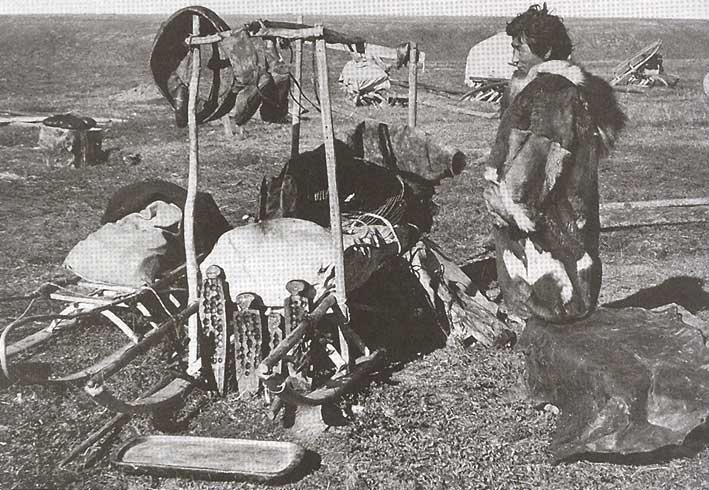Абригенов Алтая принято делить на две основные группы – северных и южных алтайцев.
К северным алтайцам относятся следующие родо-племенные группы:
1) Тубалары (туба-кижи), которые занимали долины рек Большой и Малой Иши (притоки Катуни), Кара-Кокша, Пыжи, Уйменя (притоки Бии);
2) Челканцы, расселившиеся в бассейне р. Лебеди и особенно ее притока Байгола. Они обобщенно называли себя куу-кижи, т.е. люди реки Лебеди и поэтому в этнографической литературе иногда встречаются под названием лебединцы.
3) Кумандинцы, живущие по берегам Бии от р. Лебеди вниз, почти до самого г. Бийска, а также в низовьях Катуни, где они слились с местным русским населением.
У известного исследователя Сибири 19 века В.В. Радлова кумандинцы выделены в особую самостоятельную группу северных алтайцев. Согласно же классификации В. Вербицкого, они входили в состав кочевых “черневых татар” Бийского округа. /см. Потапов Л.П., 1969 г. – С. 22-57/ Исторически кумандинцы вошли в состав Российского государства вместе с рядом других родоплеменных групп северных алтайцев вскоре после построения Кузнецкого острога в 1618 г. на реке Томи против впадения в нее реки Кондомы.
Первые упоминания о кумандинцах в русских исторических источниках относятся к 1628 г. Имеется в виду челобитная тобольских воевод, в которой говорится, что 28 февраля 1628 г. они послали из Кузнецкого острога служилых людей – “Олешку Бакая с товарищем на твою государеву службу в Чебанскую волость:”. На обратном пути четверо из них были убиты людьми телеутского князя Абака, среди которых были и кумандинцы. (Телеутское княжество существовало в Горном Алтае вплоть до середины 18 в.) Телеутские князья считали кумандинцев своими кыштымами, или данниками, которые обязаны были кроме всего прочего участвовать и в военных походах телеутских дружин. Вероятно, ранее таким же образом кумандинцы вынуждены были принимать участие в дальних военных экспедициях татаро-монгол. Так что русские, не зная того, могли познакомиться с кумандинцами значительно раньше 1628 г.
Этноним “куманды” в дореволюционный период не был самоназванием кумандинцев. Он был дан им соседними племенами (тубалары, шорцы, теленгиты, челканцы) по названию их основного и самого многочисленного рода (oре) и алтына куманды, тогда как сами себя кумандинцы называли просто “татар-кижи” (прим. “кижи” по-алтайски есть “человек”). Некоторые исследователи считают, что этноним “куманды” в переводе означает “лебедской человек” (видимо лебеди могли быть их тотемным животным). По мнению Л.П. Потапова и О. Притсака, термин “куман” в наименовании кумандинцев адекватен названию половец и кипчак. /См. Сатлаев Ф. “Кумандинцы” историко-этнограф. очерк/. Если это так, то с предками кумандинцев русские были хорошо знакомы еще до татаро-монгольского нашествия 13 века. В антропологическом плане кумандинцы, как и древние половцы, имеют много европеоидных черт. Еще первые русские землепроходцы отмечали значительное количество светловолосых и голубоглазых детей в кумандинских аилах. Вполне возможно, что алтайские кумандинцы являются потомками более древнего, чем тюрки, населения Алтая, уходящего корнями в афанасьевскую и андроновскую культуры Бронзового века.
Такие исследователи-краеведы, как А.М. Малолетко и Б.Х. Кадиков связывают происхождение кумандинцев с одним из древнейших народов Сибири – кетами. Так, согласно монографии В.И. Вербицкого (1893 г.), “названия утки в языках северных и южных алтайцев звучат соответственно – урътек и су-гуш. Первые слоги этих слов означают “вода”, но у северных алтайцев используется кетское слово “уръ”, а у южных – тюркское “су”. Также обстоит дело и со словом “айна” – “дьявол”. Ныне это слово в том же значении используют шорцы, северные алтайцы и хакасы. Южным алтайцам оно незнакомо.” /Малолетко А.М., 2000 г., С. 275-277/
На генетическую связь кумандинцев с неким древнейшим населением Сибири европеоидного типа, возможно динлинами, указывал еще в начале ХХ в. известный исследователь Центральной Азии Грум-Гржимайло: “татаро-монгольский тип, господствующий в Южном Алтае, – писал он, – превращается на севере, в лесах Бийского и Кузнецкого острогов, в почти европейский”. /Грум-Гржимайло Г.Е. 1909 г. – С. 176/. Отюречивание предков кумандинцев происходило на протяжении нескольких веков. Они входили в состав первого и второго Тюркских каганатов, испытали на себе власть Кыргызских и Уйгурских правителей (6-9 вв. н.э.). А затем по их землям прошлась конница Чингиз-хана – на несколько веков земли кумандинцев оказались в составе империи Юань, а затем “Белой Орды”.
В процессе феодального дробления в конце 13-нач. 14 вв. Золотая Орда распалась на две части, из которых восточная, включающая полосу степей от Волги до Западной Сибири, получила название Белой Орды. Феодальные распри и усобицы привели постепенно к распаду Белую Орду, в результате чего в первой половине 15 в. на ее территории происходит обособление отдельных крупных феодальных улусов: Ногайской орды, Шейбанидского улуса и Сибирского ханства.
Территориально кумандинцы входили в состав Белой Орды, а затем Сибирского ханства. /См. Nicholas Poppe. The heroic epic of the Khalha Mongols. Second Edition – The Mongolia Society, P.O. Drawer 606, Bloomington, Indiana/ Потапов Л.П. 1969 – С. 81/. И даже после разгрома последнего в результате похода дружины Ермака, кумандинцы не перестали быть данниками – теперь они обязаны были платить дань (ясак) телеутам, а потом и джунгарам (джунгары – они же ойраты, западные монголы).
С 1756 г. после поражения Джунгарии в войне с Цинской империей все алтайские племена, в том числе и кумандинцы, вошли добровольно в состав Российской империи. А по “Уставу об инородцах”, разработанному в 1822 г. М.М. Сперанским, они были отнесены в разряд “кочующих” и включены в состав Бийского уезда.
При подготовке информации использованы материалы сайта «Кумандинцы на Алтае» (http://www.bigpi.biysk.ru/altay/), сайт создан в рамках проекта «Возрождение и развитие кумандинской культуры в Алтайском крае» по гранту Губернатора Алтайского края Алекс́андра Богд́ановича Ќарлина (договор №ГУ/0124 от 15 июня 2009 года).
Авторы сайта:
Беспалов Александр Михайлович – кандидат философских наук, доцент, зав.кафедрой философии государственного образовательного учреждения высшего профессионального образования «Бийский педагогический государственный университет имени В.М. Шукшина»;
Кастаракова Валентина Макаровна, председатель АРОО «Объединение кумандинцев Алтая».




